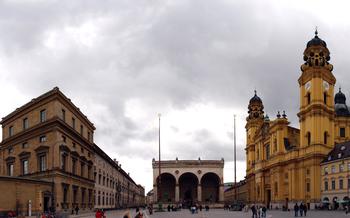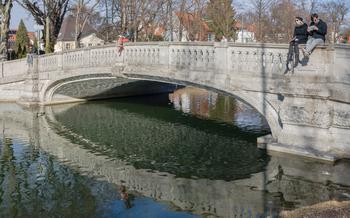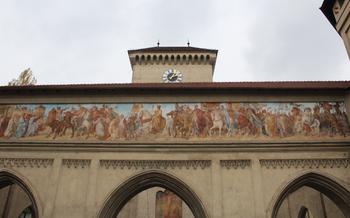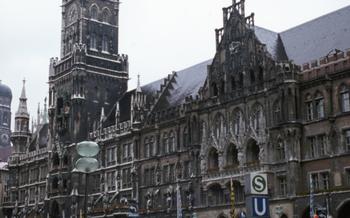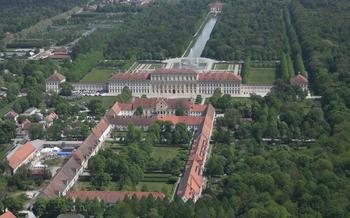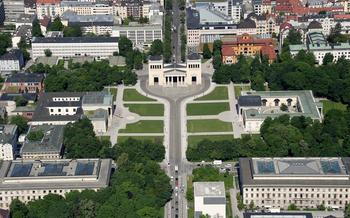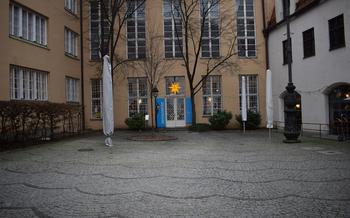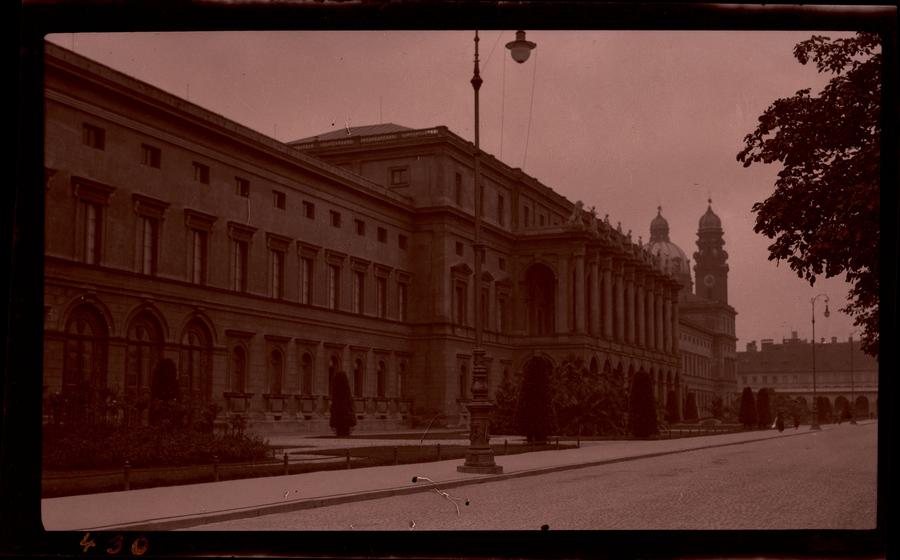
Residenz Royal Palace
- A Royal Gem in the Heart of Munich:
- Exploring the Grand Interiors: A Journey Through Splendor
- A Walk Through History
- The Cuvilliés Theatre
- The Residenz Museum: A Treasure Trove of History and Art
- The Court Garden: A Peaceful Oasis Amidst the City
- The Hercules Hall: A Realm of Myth and Majesty
- The Imperial Apartments
- The Hall of Mirrors: A Majestic Reflection of Grandeur
- The Chapel
- The Treasury
- The Porcelain Collection: A Treasure Trove of Delicate Art
- Tips for Visitors: Making the Most of Your Visit
- Insider Tip: Secrets of the Residenz
A Royal Gem in the Heart of Munich:
Nestled in the vibrant city of Munich, the Residenz Royal Palace stands as a majestic testament to the rich history and cultural heritage of Bavaria. This architectural masterpiece, steeped in centuries of royal lineage, has served as the official residence of the Wittelsbach dynasty, the former ruling family of Bavaria, for over 500 years. With its awe-inspiring grandeur and intricate blend of architectural styles, including Renaissance, Baroque, and Rococo, the Residenz Royal Palace has earned its place as one of the most significant landmarks in Munich and a must-see destination for visitors.
Situated in the heart of the city center, the Residenz Royal Palace is surrounded by a wealth of attractions, including the lively Marienplatz, the bustling Viktualienmarkt, and the iconic Frauenkirche. Its strategic location makes it an ideal starting point for exploring Munich's vibrant culinary scene, historical landmarks, and world-renowned museums.
Exploring the Grand Interiors: A Journey Through Splendor
Within the Residenz's grand walls, a treasure trove of lavish state rooms awaits visitors. Each room, adorned with intricate details and opulent furnishings, served a specific purpose in the daily life of the Bavarian monarchs. The Throne Room, with its awe-inspiring throne and opulent tapestries, exudes an air of regal authority. The State Dining Room, with its shimmering chandeliers and elegant table settings, evokes the grandeur of royal banquets. Other notable rooms include the Council Chamber, where important decisions were made, and the Library, a haven of knowledge filled with rare manuscripts.
Exquisite artwork, tapestries, and furniture adorn the palace's interiors, creating a breathtaking visual feast. Renowned artists such as Peter Paul Rubens and Francois de Cuvilliés left their indelible mark on the palace's décor. Elaborate tapestries depict scenes from mythology and history, while intricate furniture pieces, crafted from precious materials, showcase the finest craftsmanship of the era.
A highlight of the interior is the Antiquarium, a breathtaking hall that once served as the royal treasury. Today, it houses an impressive collection of antiquities, including Roman sculptures, Greek vases, and Egyptian artifacts. The grandeur of this hall, with its soaring ceiling and marble floor, is a testament to the opulence and cultural significance of the Residenz.
A Walk Through History
The Residenz Royal Palace has witnessed centuries of Bavarian history, serving as the seat of power for the Wittelsbach dynasty for over 500 years. Its grand halls and opulent chambers have been the backdrop for countless significant events and hosted a cast of fascinating characters.
One of the most notable figures associated with the palace is King Ludwig II, known for his patronage of the arts and his extravagant building projects. His contributions to the Residenz include the opulent Mirror Cabinet, a room adorned with intricate mirrors and crystal chandeliers, and the enchanting Swan Fountain in the Court Garden.
Another prominent figure is Elector Max Emanuel, who transformed the Residenz into a Baroque masterpiece during the 17th century. His vision for the palace included the construction of the magnificent Cuvilliés Theatre, a jewel of Rococo architecture, and the expansion of the art collection.
The Residenz has also played a crucial role in shaping the political landscape of Bavaria. It was here that the Bavarian Constitution was signed in 1818, establishing a constitutional monarchy. The palace also served as the meeting place for the Bavarian Parliament from 1819 to 191
Throughout its rich history, the Residenz has witnessed coronations, weddings, state banquets, and diplomatic negotiations, leaving an indelible mark on the course of Bavarian history.
The Cuvilliés Theatre
Nestled within the grand complex of the Residenz Royal Palace, the Cuvilliés Theatre stands as a testament to the architectural brilliance of the Rococo era. Designed by the renowned François de Cuvilliés, this intimate theater is considered a masterpiece of its kind. Its intricate stuccowork, delicate pastel hues, and opulent decorations create an atmosphere of elegance and grandeur.
The theater's horseshoe-shaped auditorium, adorned with intricate carvings and gilded balconies, offers an intimate setting for performances. The stage, framed by an elaborate proscenium arch, has witnessed countless theatrical productions, concerts, and operas throughout its history. The theater's acoustics are renowned for their clarity and resonance, ensuring an immersive experience for audiences.
Beyond its architectural beauty, the Cuvilliés Theatre holds historical significance as the first public theater in Munich. It played a pivotal role in the development of German theater and opera, hosting premieres of works by renowned composers such as Wolfgang Amadeus Mozart and Richard Wagner. Today, the theater continues to stage a variety of performances, including classical concerts, opera productions, and theatrical plays, offering visitors a glimpse into the rich cultural heritage of Munich.
Guided tours of the Cuvilliés Theatre are available, providing visitors with an opportunity to explore its opulent interiors, learn about its fascinating history, and discover the stories behind its many performances. Special events and cultural programs are also held throughout the year, offering visitors a unique opportunity to experience the magic of this historic theater in a truly memorable way.
The Residenz Museum: A Treasure Trove of History and Art
The Residenz Museum is housed within the Residenz Royal Palace and offers a captivating journey through Bavarian history, art, and culture. The museum showcases a diverse collection of artifacts, spanning from the Middle Ages to the 19th century. Among its highlights is the Treasury, home to the dazzling Bavarian Crown Jewels, symbolizing the opulence of the Wittelsbach dynasty. The Porcelain Collection, on the other hand, boasts an impressive array of exquisite porcelain from renowned manufactories such as Meissen and Nymphenburg, shedding light on the exquisite craftsmanship of the era. Temporary exhibitions and cultural programs further enrich the museum experience, providing visitors with a dynamic and engaging exploration of the palace's rich heritage.
The Court Garden: A Peaceful Oasis Amidst the City
Nestled amidst the bustling city of Munich, the Court Garden (Hofgarten) offers a tranquil oasis for visitors seeking respite from the urban hustle. This Baroque masterpiece, designed by the renowned architect Friedrich Ludwig von Sckell, was created as a private retreat for the Bavarian monarchs and their court. Today, it's a beloved public park that welcomes locals and tourists alike.
As you step into the Court Garden, you'll be greeted by meticulously manicured lawns, vibrant flowerbeds, and towering trees that create a sense of serenity. Baroque sculptures, fountains, and ornate gazebos adorn the garden, adding a touch of elegance to the natural beauty.
One of the highlights of the Court Garden is the Verbindungsgang, a hidden gem that connects the Residenz Palace to the garden. This arcaded walkway, adorned with intricate stucco work and vibrant frescoes, offers a glimpse into the private lives of the Bavarian royals. As you stroll through the Verbindungsgang, imagine the footsteps of kings and queens who once used this passageway to escape the confines of the palace and immerse themselves in the tranquility of the garden.
The Hercules Hall: A Realm of Myth and Majesty
Within the grand halls of the Residenz, the Hercules Hall reigns supreme, a majestic chamber that embodies the opulence and artistic prowess of the Wittelsbach dynasty. Its awe-inspiring ceiling fresco, painted by the Italian artist Giovanni Battista Tiepolo in the 18th century, transports visitors to a realm of myth and majesty. The fresco depicts the legendary labors of Hercules, a symbol of strength and heroism. The vibrant colors, intricate details, and skillful use of perspective create an illusion of depth and movement, leaving visitors spellbound.
The hall's grand scale and opulent decor were designed to impress and intimidate. It served as the stage for lavish state occasions, ceremonies, and celebrations. The Bavarian monarchs used this magnificent space to display their power and wealth, leaving a lasting impression on guests and dignitaries alike. Today, the Hercules Hall remains a testament to the grandeur of the Residenz, offering visitors a glimpse into the opulent lifestyle of the Bavarian court.
The Imperial Apartments
The Imperial Apartments offer a glimpse into the private lives of the Bavarian monarchs. These opulent living quarters, reserved for the royal family, are a testament to their luxurious lifestyle and impeccable taste. Each room is meticulously decorated, showcasing a blend of grandeur and comfort.
Highlights:
-
The Mirror Cabinet, a small but extravagant room adorned with mirrors and delicate paintings, served as a private retreat for the queen.
-
The Bedroom of Ludwig II, the renowned Bavarian king known for his patronage of the arts, features intricate wood carvings and a majestic bed that reflects his eccentric personality.
-
The Royal Dining Room, where the monarchs and their guests indulged in lavish feasts, boasts a stunning ceiling fresco depicting scenes from Greek mythology.
-
The Throne Room, the seat of royal power, is resplendent with gold-leaf decorations and a grand throne that symbolizes the authority of the Bavarian monarchy.
The Hall of Mirrors: A Majestic Reflection of Grandeur
The Hall of Mirrors, a dazzling testament to Baroque opulence, is undoubtedly one of the most captivating spaces within the Residenz. Inspired by the iconic Hall of Mirrors at the Palace of Versailles, this grand chamber exudes an aura of regal splendor and extravagance.
Its walls are adorned with intricate mirror decorations, reflecting the shimmering light from the opulent crystal chandeliers that hang from the ceiling. The play of light and reflections creates a captivating ambiance, amplifying the hall's sense of grandeur and spaciousness.
Originally conceived as a ballroom, the Hall of Mirrors served as a grand stage for lavish receptions, festivities, and courtly gatherings. Here, the Bavarian monarchs and their guests would promenade, dance, and engage in lively conversations amidst the hall's opulent surroundings.
The Hall of Mirrors stands as a testament to the artistic mastery and craftsmanship of its time. Its exquisite décor, coupled with its historical significance, makes it a must-see attraction for any visitor to the Residenz Royal Palace.
The Chapel
Within the grand walls of the Residenz Royal Palace, a sacred space unfolds, revealing the spiritual side of the Bavarian monarchy. The Chapel, a sanctuary of faith and devotion, stands as a testament to the deep religious traditions that shaped the Wittelsbach dynasty.
With its intricate Gothic architecture and ornate Baroque embellishments, the Chapel exudes an aura of reverence and awe. The vaulted ceilings, adorned with delicate frescoes depicting biblical scenes, invite visitors to contemplate the divine. Stained glass windows, casting colorful hues upon the marble floors, add to the ethereal ambiance.
The Chapel served as a private place of worship for the royal family and their court. Here, they gathered for prayers, masses, and religious ceremonies, seeking solace and guidance from a higher power. The altar, adorned with intricate carvings and precious stones, became the focal point of their spiritual devotions.
Beyond its religious significance, the Chapel also holds historical importance. It witnessed numerous royal weddings, christenings, and other momentous events that shaped the course of Bavarian history. The echoes of royal vows, the cries of newborn heirs, and the prayers of generations past still linger within these sacred walls.
Whether seeking spiritual reflection or a glimpse into the religious life of the Bavarian monarchy, the Chapel offers a unique and poignant experience for visitors to the Residenz Royal Palace. It invites them to connect with the deeper dimensions of history, where faith and power intertwined to create a legacy that continues to inspire and fascinate.
The Treasury
The Residenz Treasury is a treasure trove of royal opulence and historical significance. It houses a dazzling collection of jewels, precious objects, and artifacts that once belonged to the Wittelsbach dynasty, the former rulers of Bavaria. Among the highlights of the collection are the Bavarian Crown Jewels, which include the magnificent Bavarian Crown, adorned with over 3,000 diamonds and precious stones. Other notable pieces include gold and silver tableware, intricate goldsmith work, and exquisite gemstones.
Visitors to the Treasury are transported back in time as they marvel at the craftsmanship and artistry of these priceless objects. Each piece tells a story of power, wealth, and the grandeur of the Wittelsbach court. The Treasury is a testament to the opulence and extravagance that defined the royal lifestyle of a bygone era.
The Porcelain Collection: A Treasure Trove of Delicate Art
The Residenz Museum is home to an extensive collection of porcelain, showcasing exquisite pieces from around the world. The collection has historical significance, as it reflects the taste and opulence of the Bavarian monarchs. The porcelain pieces are not only beautiful but also hold artistic value, representing different styles and techniques from various periods.
Among the highlights of the collection are the Meissen and Nymphenburg porcelain items. Meissen porcelain, known for its delicate white color and intricate hand-painted designs, is considered one of the finest in the world. The collection features a range of Meissen pieces, from tableware to figurines. Nymphenburg porcelain, another renowned German brand, is represented by a variety of items, including vases, sculptures, and dinnerware.
The Residenz Porcelain Collection offers a glimpse into the refined taste and extravagance of the Bavarian court. It showcases the monarchs' appreciation for fine craftsmanship and their desire to surround themselves with beautiful objects. Whether you are a porcelain enthusiast or simply admire exquisite craftsmanship, this collection is a must-see for anyone visiting the Residenz Museum.
Tips for Visitors: Making the Most of Your Visit
To fully appreciate the grandeur of the Residenz Royal Palace, plan your visit carefully. The best time to visit is during the shoulder seasons (spring and autumn) when the weather is pleasant and the crowds are smaller. Guided tours are available in multiple languages and provide an in-depth insight into the palace's history and significance. The Residenz is wheelchair accessible, with ramps and elevators available for visitors with limited mobility.
While photography is allowed in most areas of the palace, there are some restrictions. Flash photography and tripods are not permitted in certain rooms to protect the artwork and artifacts. Be sure to check the guidelines before taking pictures.
After exploring the palace, take some time to stroll through the surrounding area. The Odeonsplatz, with its majestic buildings and monuments, is just a stone's throw away. For a bite to eat, head to the nearby Viktualienmarkt, a lively market with a wide variety of food stalls and restaurants.
Insider Tip: Secrets of the Residenz
Beyond the grand halls and opulent chambers, the Residenz Royal Palace holds secrets waiting to be uncovered. Explore hidden passageways that once allowed royalty to move unseen through the palace. Discover secret corners that offer a glimpse into the private lives of the Wittelsbachs. Join special events and behind-the-scenes tours that delve deeper into the palace's history and hidden treasures. Don't miss the lesser-known attractions within the palace complex, such as the Marstallmuseum, which houses a collection of royal carriages and sleighs, or the Hofgarten, a tranquil garden with a unique perspective of the palace.

